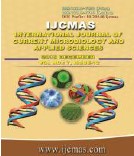


 National Academy of Agricultural Sciences (NAAS)
National Academy of Agricultural Sciences (NAAS)

|
PRINT ISSN : 2319-7692
Online ISSN : 2319-7706 Issues : 12 per year Publisher : Excellent Publishers Email : editorijcmas@gmail.com / submit@ijcmas.com Editor-in-chief: Dr.M.Prakash Index Copernicus ICV 2018: 95.39 NAAS RATING 2020: 5.38 |
Neonatal septicemia is still a leading cause of mortality and morbidity in developing countries like India. This prospective study involved 382 clinically suspected cases of neonatal septicemia over a period of one year from April 2014 to March 2015. Of the total 382 cases studied 174 (45.54%) were blood culture positive. Among the culture positive cases, septicemia was more common in male neonates, seen in 55.23%, compared to 44.76% of female neonates. Of the 174 culture positive cases, early onset septicemia (EOS) was more common, seen in 75.86% compared to late onset septicemia (LOS) in 24.14% of the cases. Gram negative organisms were the predominant causative agents of septicemia in(61.49%), compared to Gram positive organisms in (38.50%) of the cases. Klebsiella pneumoniae was the commonest gram negative isolate in 39.65% of cases, followed by Staphylococcus aureus in 22.41% of cases. All the Gram positive isolates were 100% susceptible to Vancomycin followed by Amikacin 94.87% , linezolid 89.74% and 100% resistant to Penicillin . Majority of Gram negative isolates were susceptible to Meropenem followed by Amikacin and ciprofloxacin, while maximum resistance was noted with Ampicillin, followed by Cefuroxime, Cefotaxime, Ceftazidime and Gentamicin . To conclude, Blood culture is still the “Gold standard” for the diagnosis of septicemia in neonates and should be done in all cases of suspected septicemia prior to starting the antibiotics.
 |
 |
 |
 |
 |